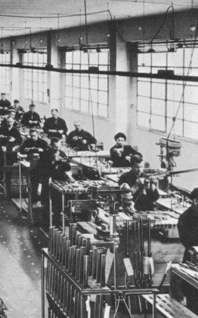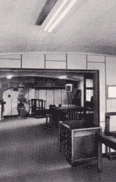From "Beretta Pistols: The Ultimate Guide" by J.B. Wood - (c) StoegerBooks |
|
The smallest of the Beretta pistols borrowed a major design feature from several earlier guns - the French Le Francais, the Spanish Jo Lo Ar, the Belgian Piper, and the Austrian Steyr copy of the last one named. The feature was a barrel that could be released by a side lever to tip upward at the rear, exposing the chamber for loading and easy cleaning. This also made the pistol especially convenient for anyone with weak hands, who might have difficulty in cycling the slide against the tension of the recoil spring.
The pistol, available in 6.35mm (25 Auto) and in 22 Short chambering, was first designated Model 950. In its earliest form, the pistol had twin torsion-type recoil springs, located inside the grip panels on each side of the frame. The springs were the round-wire type, with the heavier springs of the .25 version cut flat over their entire length.
The lighter 22 springs were flat only in the upper half of their forward arms. The true Model 950 was not made for long. The twin recoil springs were soon replaced by a single combination torsion spring, centrally mounted on a pin behind the trigger. The short center loop of the spring tensioned the barrel latch, and twin arms extended to the rear, then upward to contact notches in the lower edge of the slide. The springs for the .25 and 22 versions differed only in their diameter and strength.
In regular production, the 25 was now designated Model 950B, and the .22, Model 950CC. There was also another version of the .22, the Model 950CC Special. It had a longer (95mm or 3.74 inches) bar-rel. The only safety provided was a deep first-notch on the external hammer that kept the hammer face out of contact with the head of the firing pin. If the pistol was carried with the chamber loaded, use of the safety notch was mandatory, as the firing pin was a full-reach non-inertia type. The magazine catch was a cross-bolt type, located on the left side in the lower rear area of the grip panel. On the earliest guns, the catch button was checkered. |
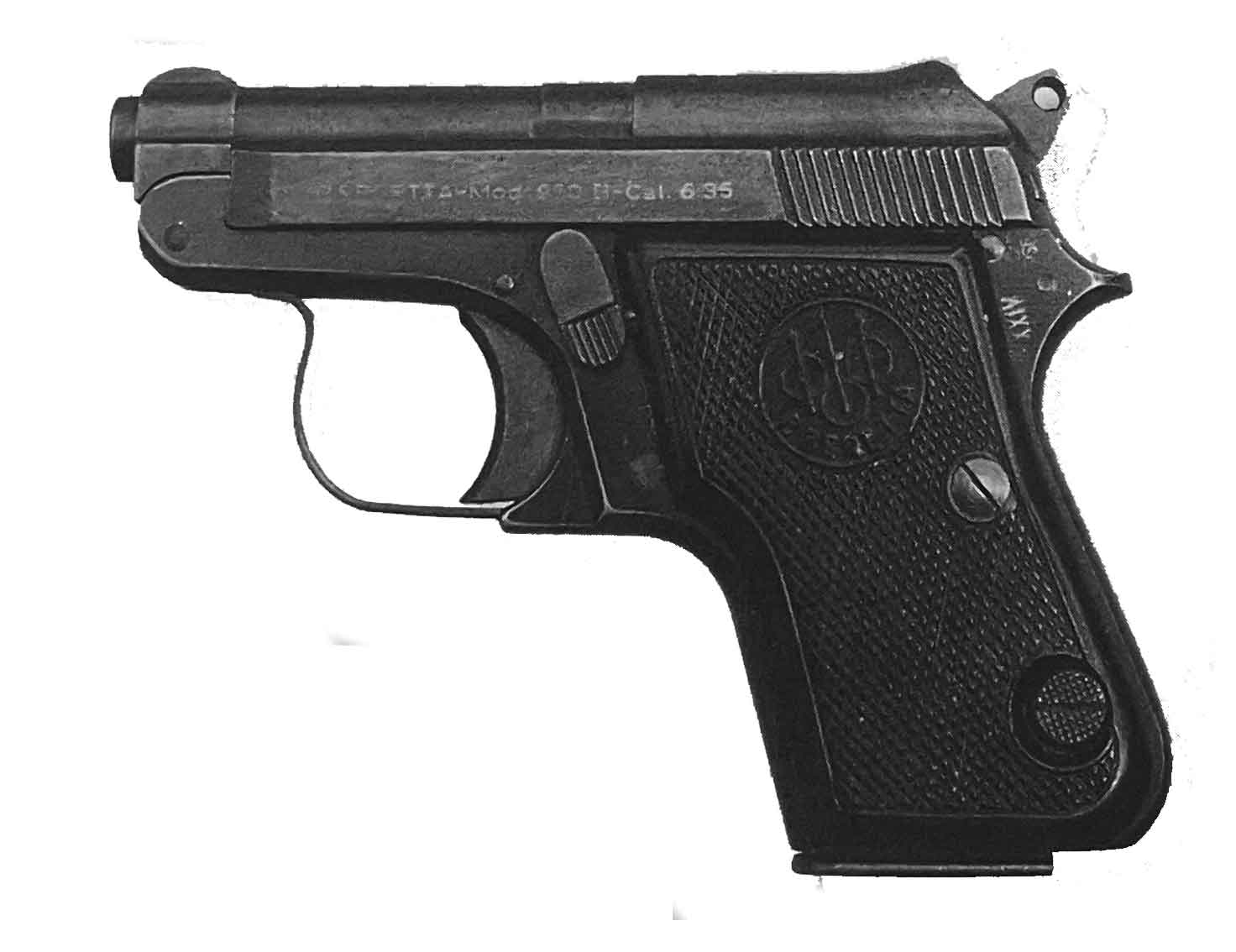
Proof-dated 1968, this Model 950B in .25 Auto was part of the last group to enter the U.S. before the law of that year banned the importation of small pistols. The serial number is G43794. Note the checkered magazine release button.
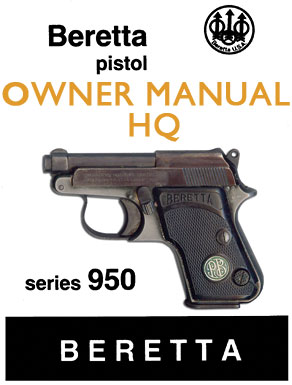
CLICK & DOWNLOAD 10MB
|
The early Model 950 pistols lacked heavy "wings" on each side of the barrel at the muzzle that were added on the Model 950B. Two early slide markings have been observed: one single line, "P. BERETTA - CAL. 6.35 - BREV. 950, the other - on a pistol proof-dated 1950
- in three lines, "P. BERETTA - CAL, 635 - BREVET." "GARDONE V.T. (ITALIA)," and "1950. This pistol has grips with the name "BE-RETTA" placed in an irregular oblong at the top, and a round, silver "PB" medallion in the lower checkered area. The magazine catch button was flat and checkered. The forward edges of the slide were square and unbevelled.
By 1953, when the new small pistols began to be generally available in the United States the "cc" suffix on the .22 Short version no longer was being used. Both the rimfire and the centerfire had slide markings that were the same, except for the caliber designation. On the .22, it was "BERETTA - MOD. 950B - CAL. 22 SHORT, and the last part of the .25 marking was "CAL. 6.35. At some point, the magazine catch button was changed from a flat checkered form to one that was domed and polished.
For the American market, the 22 was called the "Minx" and the 25 the "Jetfire”. The plastic grips had a large circle near the top with the three arrows, three small circles, and the name "BERETTA" below them, following the curve of the circle rim. Lower on the checkered grip, a smaller circle carried the designations "22 SHORT" and "MINX" A similar grip was used on the centerfire model with the small lower circle bearing "25" and "JETFIRE." During this period (circa 1954), the retail price of the 950B in .25 Auto was $40. The .22 Short was slightly higher - $42.95. The added amount for the .22 Minx reflected the extra work involved in manufacturing the rimfire firing pin, and the 22 magazine.
One other mechanical feature of the Model 950 and its later variations should be noted. The pistol has a conventional fixed ejector mounted on the frame, but there is no extractor. Both the .25 Auto and the .22 Short have minimal obturation when fired, and the chamber adhesion factor of these rounds is so small that it can be ignored.
On firing, the empty cartridge case simply blows out of the chamber, its head supported by the breech face of the slide, until its rim encounters the ejector. This system works perfectly. I carried and used a 22 Model 950B for several years as a camping gun, and in firing several thousand rounds, I did not experience a single malfunction. |
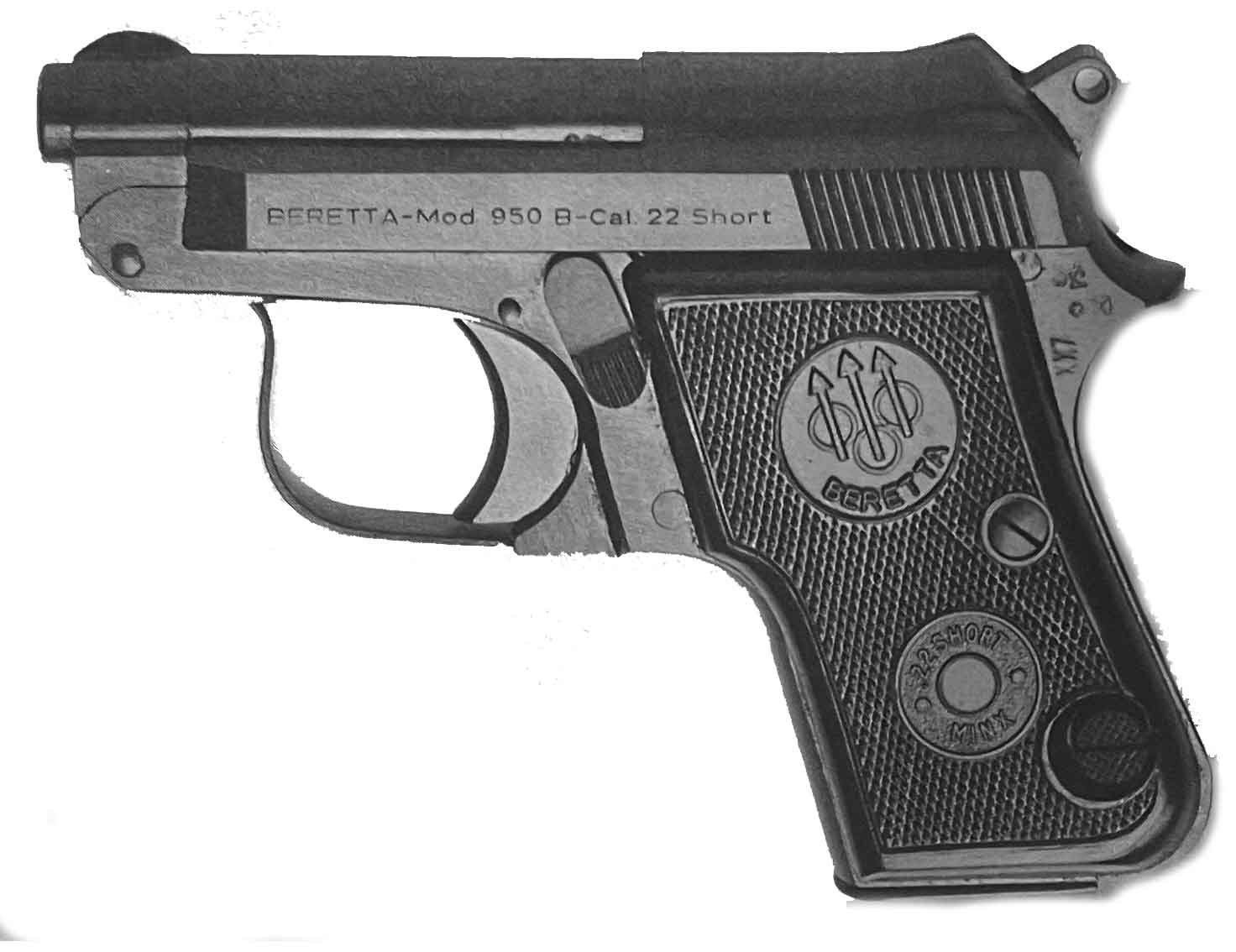
Model 950B, this one proof-dated 1971. Note the beveled edges at the front of the slide, and the contoured side "wings" on the barrel at the muzzle. (Beretta Archives)
|
With the quality control of modern .25 and .22 cartridges, a misfire is highly unlikely. If one should occur in the small Beretta, the lack of an extractor is no problem. If the barrel latch is tripped and the barrel is allowed to spring forward, a chambered loaded round will be thrown out. Or, if the barrel is restrained on opening, the round can be easily shaken out into the palm of the hand. In normal un-loading, the latter method should be used. If the pistol is being used for self-defense, the first method will instantly clear the chamber, and the slide can then be quickly cycled to chamber a fresh round.
During its period of manufacture, the Model 950B was also produced in a Beretta facility in Brazil, and some of these pistols were imported into the United States. The full address of the Beretta factory in South America was Beretta S.A., Av. da V. Manzini 450, Santo Amaro/Sao Paulo, Brazil. The Brazilian-made Model 950B was produced with Beretta tooling and under Beretta supervision. These guns were identical in every way to those made in Italy, including the markings on the left side flat. On the right side of the slide, they were marked "MADE IN BRAZIL"
Along with several other fine European pistols, the Model 950B was caught in 1968 by the new U.S. importation restrictions, and was banned because of its small size. For about 10 years, none of these excellent little guns came to America. Then, in 1977, Beretta and Leo Goldsmith Jr., a U.S. business associate, arranged for production of the small Beretta at the Firearms International factory in Accokeek, Maryland, a facility that later became Beretta U.S.A. By the time this occurred, two important changes had been added to the pistols. The firing pin was now an inertia type, allowing safe hammer-down carrying with the chamber loaded, and there was now a manual sear-block safety, located at the top rear corner of the left grip panel. |
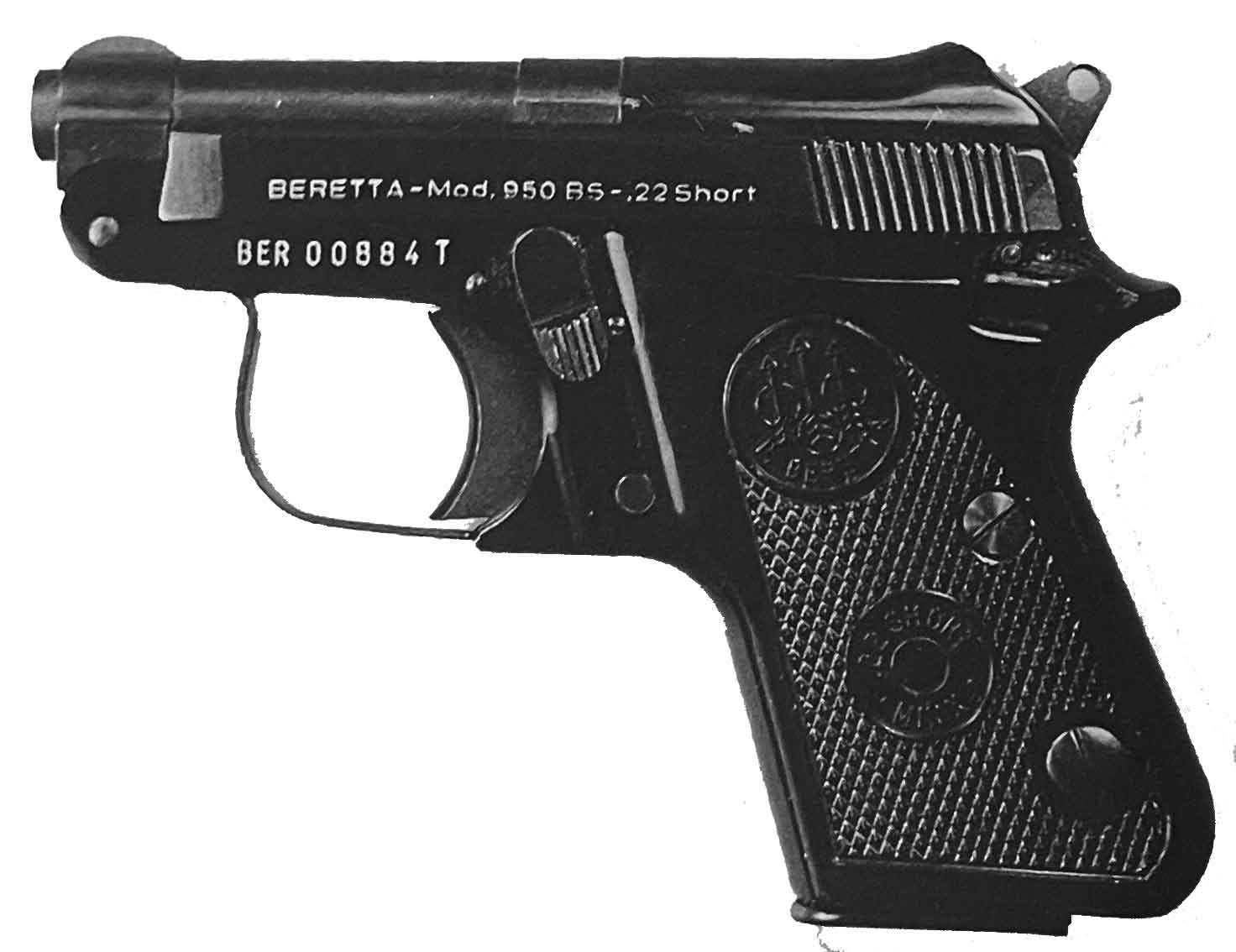
An early U.S.-made .22 Minx also has Firearms International markings. Both the Jetfire and the Minx were later marked "MADE BERETTA USA CORP. ACKK, MD" on the right side of the slide.
|
The new American-made pistols were designated Model 950BS, the added "S" obviously a reference to the manual safety. On the left slide flat, the marking on the .22 version was "BERETTA- Mod. 950BS- 22 Short." The 25 marking was the same, except for the cartridge designation, which was "25 Cal" On the right slide flat, early pistols were marked "MADE IN USA BY F.I. IND. ACKK, MD." This latter marking was soon changed to "MADE BERETTA USA CORP, ACKK, MD." The serial number now appeared on the left side of the frame near the front. (The earlier 950B pistols were numbered on the right side of the frame above the trigger opening, and the right slide flat was marked "MADE IN ITALY.") Tooling and supervision for the production of the Model 950BS in the Maryland facility was supplied by the Beretta factory, and the quality and features of the pistols are the same as those made in Italy. |
| |
The pre-1968 Italian pistols are easily identified by their proof marks and the absence of a manual safety. It may be of interest to note that all of the .22 magazines I have seen are marked on the left side, near the edge, "P.B. CAL. 22 SHORT MADE IN ITALY, while the magazine in my .25 pistol is only marked on the floor plate "25 CAL." The U.S.-made Model 950BS pistols retained the trade names and grip styles of the earlier guns, with the 22 Short version still known as the Minx and the .25 Auto as the Jetfire. Between the years 2000 and 2002, a final run of the 25 was offered in an "Inox" version (stainless steel). Up to 1999, a fancy version was available, the Model 950EL, with gold-plated small parts and wood grips. The Model 950BS in 22 Short was discontinued in 1993, and the .25 pistol went out of production in 2002.
|
Specifications :
Overall
Length
115
mm
Height
85 mm
Length of barrel
60 mm
Weight of pistol with empty magazine
280 gr
|
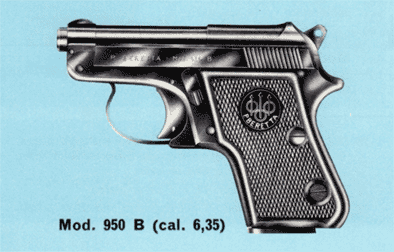
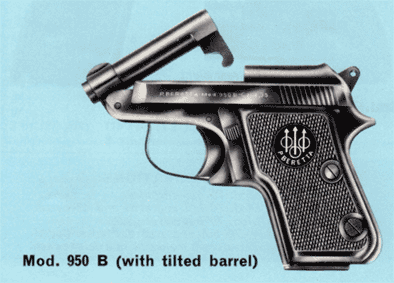
|
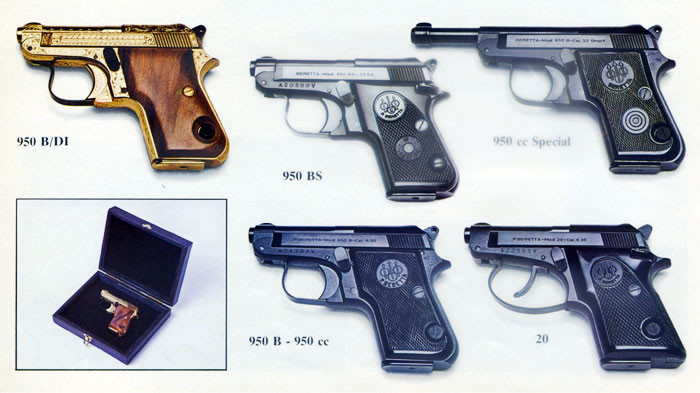 |
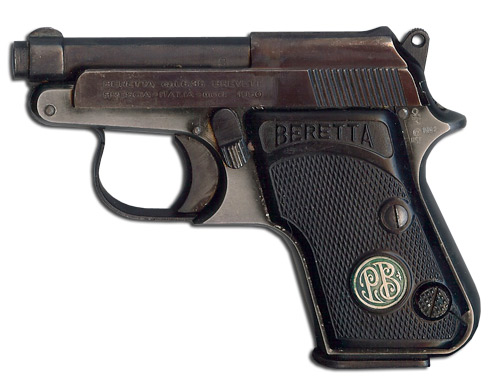
Cool picture from a USA gun-owner (made in Italy 1952) |
|
|



